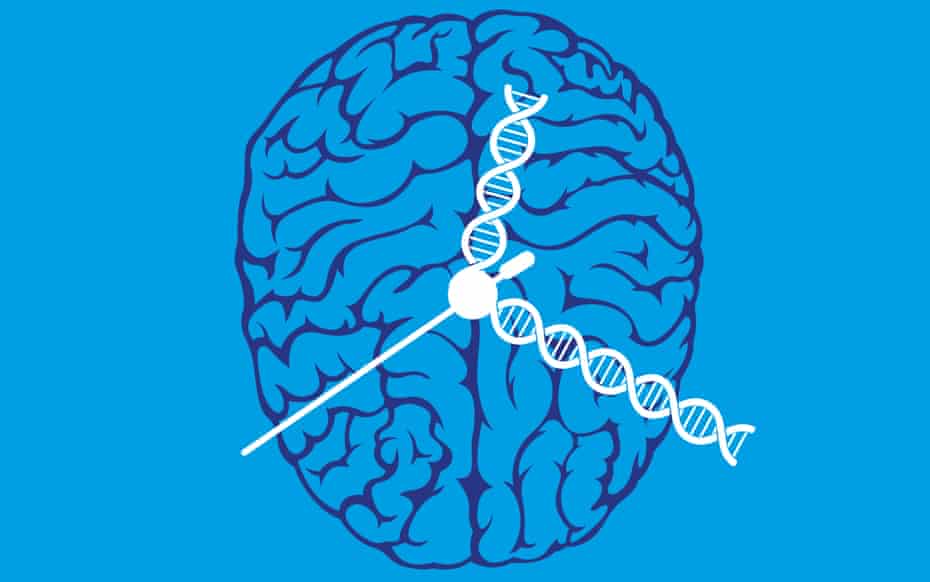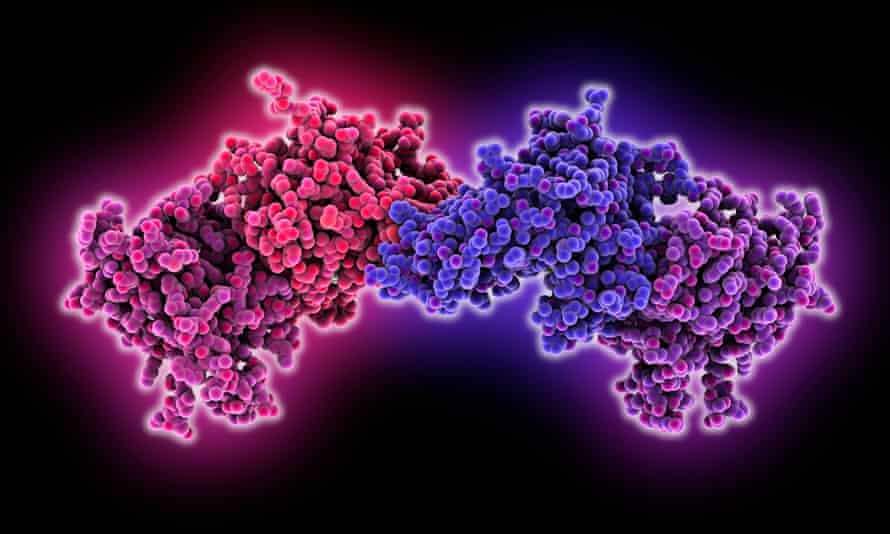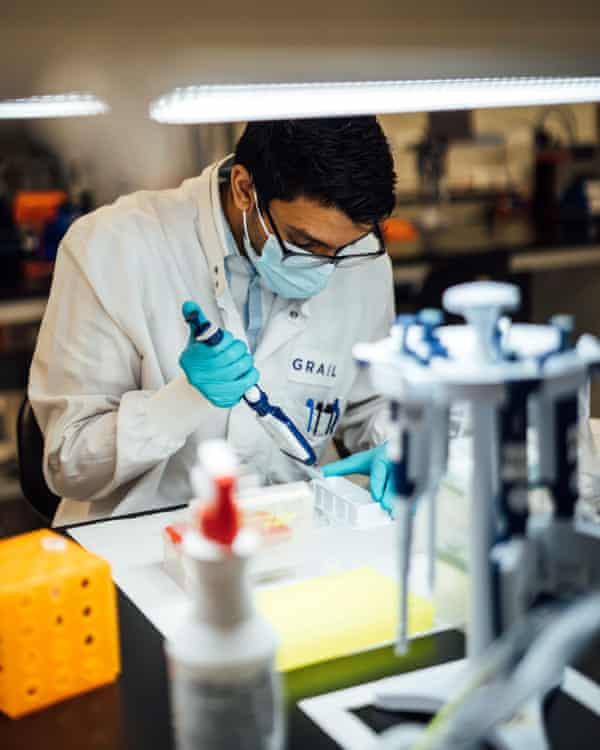
Illustration by Philip Lay.
The study of the epigenome came with claims that trauma could be inherited, but now researchers are more excited about its potential to measure the risk of disease
Laura Spinney
Sun 10 Oct 2021
Alittle over a decade ago, a clutch of scientific studies was published that seemed to show that survivors of atrocities or disasters such as the Holocaust and the Dutch famine of 1944-45 had passed on the biological scars of those traumatic experiences to their children.
The studies caused a sensation, earning their own BBC Horizon documentary and the cover of Time (I also wrote about them, for New Scientist) – and no wonder. The mind-blowing implications were that DNA wasn’t the only mode of biological inheritance, and that traits acquired by a person in their lifetime could be heritable. Since we receive our full complement of genes at conception and it remains essentially unchanged until our death, this information was thought to be transmitted via chemical tags on genes called “epigenetic marks” that dial those genes’ output up or down. The phenomenon, known as transgenerational epigenetic inheritance, caught the public imagination, in part because it seemed to release us from the tyranny of DNA. Genetic determinism was dead.
A decade on, the case for transgenerational epigenetic inheritance in humans has crumbled. Scientists know that it happens in plants, and – weakly – in some mammals. They can’t rule it out in people, because it’s difficult to rule anything out in science, but there is no convincing evidence for it to date and no known physiological mechanism by which it could work. One well documented finding alone seems to present a towering obstacle to it: except in very rare genetic disorders, all epigenetic marks are erased from the genetic material of a human egg and sperm soon after their nuclei fuse during fertilisation. “The [epigenetic] patterns are established anew in each generation,” says geneticist Bernhard Horsthemke of the University of Duisburg-Essen in Germany.
The study of epigenetics seems to reinforce the case that it’s not nature versus nurture, but nature plus nurture
Even at the time, sceptics pointed out that it was fiendishly difficult to disentangle the genetic, epigenetic and environmental contributions to inherited traits. For one thing, a person shares her mother’s environment from the womb on, so that person’s epigenome could come to resemble her mother’s without any information being transmitted via the germline, or reproductive cells. In the past decade, the threads have become even more tangled, because it turns out that epigenetic marks are themselves largely under genetic control. Some genes influence the degree to which other genes are annotated – and this shows up in twin studies, where certain epigenetic patterns have been found to be more similar in identical twins that in non-identical ones.
This has led researchers to think of the epigenome less as the language in which the environment commands the genes, and more as a way in which the genes adjust themselves to respond better to an unpredictable environment. “Epigenetics is often presented as being in opposition to genetics, but actually the two things are intertwined,” says Jonathan Mill, an epigeneticist at the University of Exeter. The relationship between them is still being worked out, but for geneticist Adrian Bird of the University of Edinburgh, the role of the environment in shaping the epigenome has been exaggerated. “In fact, cells go to quite a lot of trouble to insulate themselves from environmental insult,” he says.
Whatever that relationship turns out to be, the study of epigenetics seems to reinforce the case that it’s not nature versus nurture, but nature plus nurture (so genetic determinism is still dead). And whatever the contribution of the epigenome, it doesn’t seem to translate across generations.
All the aforementioned researchers rue the fact that transgenerational epigenetic inheritance is still what most people think of when they hear the word epigenetics, because the past decade has also seen exciting advances in the field, in terms of the light it has shed on human health and disease. The marks that accumulate on somatic cells – that is, all the body’s cells except the reproductive ones – turn out to be very informative about these, and new technologies have made it easier to read them.
The study of the epigenome came with claims that trauma could be inherited, but now researchers are more excited about its potential to measure the risk of disease
Laura Spinney
Sun 10 Oct 2021
Alittle over a decade ago, a clutch of scientific studies was published that seemed to show that survivors of atrocities or disasters such as the Holocaust and the Dutch famine of 1944-45 had passed on the biological scars of those traumatic experiences to their children.
The studies caused a sensation, earning their own BBC Horizon documentary and the cover of Time (I also wrote about them, for New Scientist) – and no wonder. The mind-blowing implications were that DNA wasn’t the only mode of biological inheritance, and that traits acquired by a person in their lifetime could be heritable. Since we receive our full complement of genes at conception and it remains essentially unchanged until our death, this information was thought to be transmitted via chemical tags on genes called “epigenetic marks” that dial those genes’ output up or down. The phenomenon, known as transgenerational epigenetic inheritance, caught the public imagination, in part because it seemed to release us from the tyranny of DNA. Genetic determinism was dead.
A decade on, the case for transgenerational epigenetic inheritance in humans has crumbled. Scientists know that it happens in plants, and – weakly – in some mammals. They can’t rule it out in people, because it’s difficult to rule anything out in science, but there is no convincing evidence for it to date and no known physiological mechanism by which it could work. One well documented finding alone seems to present a towering obstacle to it: except in very rare genetic disorders, all epigenetic marks are erased from the genetic material of a human egg and sperm soon after their nuclei fuse during fertilisation. “The [epigenetic] patterns are established anew in each generation,” says geneticist Bernhard Horsthemke of the University of Duisburg-Essen in Germany.
The study of epigenetics seems to reinforce the case that it’s not nature versus nurture, but nature plus nurture
Even at the time, sceptics pointed out that it was fiendishly difficult to disentangle the genetic, epigenetic and environmental contributions to inherited traits. For one thing, a person shares her mother’s environment from the womb on, so that person’s epigenome could come to resemble her mother’s without any information being transmitted via the germline, or reproductive cells. In the past decade, the threads have become even more tangled, because it turns out that epigenetic marks are themselves largely under genetic control. Some genes influence the degree to which other genes are annotated – and this shows up in twin studies, where certain epigenetic patterns have been found to be more similar in identical twins that in non-identical ones.
This has led researchers to think of the epigenome less as the language in which the environment commands the genes, and more as a way in which the genes adjust themselves to respond better to an unpredictable environment. “Epigenetics is often presented as being in opposition to genetics, but actually the two things are intertwined,” says Jonathan Mill, an epigeneticist at the University of Exeter. The relationship between them is still being worked out, but for geneticist Adrian Bird of the University of Edinburgh, the role of the environment in shaping the epigenome has been exaggerated. “In fact, cells go to quite a lot of trouble to insulate themselves from environmental insult,” he says.
Whatever that relationship turns out to be, the study of epigenetics seems to reinforce the case that it’s not nature versus nurture, but nature plus nurture (so genetic determinism is still dead). And whatever the contribution of the epigenome, it doesn’t seem to translate across generations.
All the aforementioned researchers rue the fact that transgenerational epigenetic inheritance is still what most people think of when they hear the word epigenetics, because the past decade has also seen exciting advances in the field, in terms of the light it has shed on human health and disease. The marks that accumulate on somatic cells – that is, all the body’s cells except the reproductive ones – turn out to be very informative about these, and new technologies have made it easier to read them.

A model of DNA methylation – the process that modulates genes. The influence of environment or lifestyle on this process is being studied. Photograph: Laguna Design/Science Photo Library
Different people define epigenetics differently, which is another reason why the field is misunderstood. Some define it as modifications to chromatin, the package that contains DNA inside the nuclei of human cells, while others include modifications to RNA. DNA is modified by the addition of chemical groups. Methylation, when a methyl group is added, is the form of DNA modification that has been studied most, but DNA can also be tagged with hydroxymethyl groups, and proteins in the chromatin complex can be modified too.
Researchers can generate genome-wide maps of DNA methylation and use these to track biological ageing, which as everyone knows is not the same as chronological ageing. The first such “epigenetic clocks” were established for blood, and showed strong associations with other measures of blood ageing such as blood pressure and lipid levels. But the epigenetic signature of ageing is different in different tissues, so these couldn’t tell you much about, say, brain or liver. The past five years have seen the description of many more tissue-specific epigenetic clocks.
Mill’s group is working on a brain clock, for example, that he hopes will correlate with other indicators of ageing in the cortex. He has already identified what he believes to be an epigenetic signature of neurodegenerative disease. “We’re able to show robust differences in DNA methylation between individuals with and without dementia, that are very strongly related to the amount of pathology they have in their brains,” Mill says. It’s not yet possible to say whether those differences are a cause or consequence of the pathology, but they provide information about the mechanisms and genes that are disrupted in the disease process, that could guide the development of novel diagnostic tests and treatments. If a signal could be found in the blood, say, that correlated with the brain signal they’ve detected, it could form the basis of a predictive blood test for dementia.
Different people define epigenetics differently, which is another reason why the field is misunderstood. Some define it as modifications to chromatin, the package that contains DNA inside the nuclei of human cells, while others include modifications to RNA. DNA is modified by the addition of chemical groups. Methylation, when a methyl group is added, is the form of DNA modification that has been studied most, but DNA can also be tagged with hydroxymethyl groups, and proteins in the chromatin complex can be modified too.
Researchers can generate genome-wide maps of DNA methylation and use these to track biological ageing, which as everyone knows is not the same as chronological ageing. The first such “epigenetic clocks” were established for blood, and showed strong associations with other measures of blood ageing such as blood pressure and lipid levels. But the epigenetic signature of ageing is different in different tissues, so these couldn’t tell you much about, say, brain or liver. The past five years have seen the description of many more tissue-specific epigenetic clocks.
Mill’s group is working on a brain clock, for example, that he hopes will correlate with other indicators of ageing in the cortex. He has already identified what he believes to be an epigenetic signature of neurodegenerative disease. “We’re able to show robust differences in DNA methylation between individuals with and without dementia, that are very strongly related to the amount of pathology they have in their brains,” Mill says. It’s not yet possible to say whether those differences are a cause or consequence of the pathology, but they provide information about the mechanisms and genes that are disrupted in the disease process, that could guide the development of novel diagnostic tests and treatments. If a signal could be found in the blood, say, that correlated with the brain signal they’ve detected, it could form the basis of a predictive blood test for dementia.

Details about smoking habits can be detected from the epigenome – researchers are working on a clinical application for these observations.
Photograph: Chris Rout/Alamy
While Bird and others argue that the epigenome is predominantly under genetic control, some researchers are interested in the trace that certain environmental insults leave there. Smoking, for example, has a clear epigenetic signature. “I could tell you quite accurately, based on their DNA methylation profile, if someone was a smoker or not, and probably how much they smoked and how long they had smoked for,” says Mill.
James Flanagan of Imperial College London is among those who are exploiting this aspect of the epigenome to try to understand how lifestyle factors such as smoking, alcohol and obesity shape cancer risk. Indeed, cancer is the area where there is most excitement in terms of the clinical application of epigenetics. One idea, Flanagan says, is that once informed of their risk a person could make lifestyle adjustments to reduce it.
Drugs that remodel the epigenome have been used therapeutically in those already diagnosed with cancer, though they tend to have bad side-effects because their epigenetic impact is so broad. Other widely prescribed drugs that have few side-effects might turn out to work at least partly via the epigenome too. Based on the striking observation that breast cancer risk is more than halved in diabetes patients who have taken the diabetes drug metformin for a long time, Flanagan’s group is investigating whether this protective effect is mediated by altered epigenetic patterns.
Meanwhile, the US-based company Grail – which has just been bought, controversially, by DNA sequencing giant Illumina – has come up with a test for more than 50 cancers that detects altered methylation patterns in DNA circulating freely in the blood.

Last month the NHS launched a trial of Grail’s Galleri blood test, designed to detect epigenetic modifications that identify more than 50 types of cancer.
Photograph: Grail
Based on publicly available data on its false-positive and false-negative rates, the Grail test looks very promising, says Tomasz K Wojdacz, who studies clinical epigenetics at the Pomeranian Medical University in Szczecin, Poland. But more data is needed and is being collected now in a major clinical trial in the NHS. The idea is that the test would be used to screen populations, identifying individuals at risk who would then be guided towards more classical diagnostic procedures such as tissue-specific biopsies. It could be a gamechanger in cancer, Wojdacz thinks, but it also raises ethical dilemmas, that will have to be addressed before it is rolled out. “Imagine that someone got a positive result but further investigations revealed nothing,” he says. “You can’t put that kind of psychological burden on a patient.”
The jury is out on whether it’s possible to wind back the epigenetic clock. This question is the subject of serious inquiry, but many researchers worry that as a wave of epigenetic cosmetics hits the market, people are parting with their money on the basis of scientifically unsupported claims. Science has only scratched the surface of the epigenome, says Flanagan. “The speed at which these things happen and the speed at which they might change back is not known.” It might be the fate of every young science to be misunderstood. That’s still true of epidenetics, but it could about to change.
Based on publicly available data on its false-positive and false-negative rates, the Grail test looks very promising, says Tomasz K Wojdacz, who studies clinical epigenetics at the Pomeranian Medical University in Szczecin, Poland. But more data is needed and is being collected now in a major clinical trial in the NHS. The idea is that the test would be used to screen populations, identifying individuals at risk who would then be guided towards more classical diagnostic procedures such as tissue-specific biopsies. It could be a gamechanger in cancer, Wojdacz thinks, but it also raises ethical dilemmas, that will have to be addressed before it is rolled out. “Imagine that someone got a positive result but further investigations revealed nothing,” he says. “You can’t put that kind of psychological burden on a patient.”
The jury is out on whether it’s possible to wind back the epigenetic clock. This question is the subject of serious inquiry, but many researchers worry that as a wave of epigenetic cosmetics hits the market, people are parting with their money on the basis of scientifically unsupported claims. Science has only scratched the surface of the epigenome, says Flanagan. “The speed at which these things happen and the speed at which they might change back is not known.” It might be the fate of every young science to be misunderstood. That’s still true of epidenetics, but it could about to change.
Sequencing the epigenome
Until recently, sequencing the epigenome was a relatively slow and expensive affair. To identify all the methyl tags on the genome, for example, would require two distinct sequencing efforts and a chemical manipulation in between. In the past few years, however, it has become possible to sequence the genome and its methylation pattern simultaneously, halving the cost and doubling the speed.
Oxford Nanopore Technologies, the British company responsible for much of the tracking of the global spread of Covid-19 variants, which floated on the London Stock Exchange last week, offers such a technology. It works by pushing DNA through a nanoscale hole while current passes either side. DNA consists of four bases or letters – A, C, G and T – and because each one has a unique shape in the nanopore it distorts the current in a unique and measurable way. A methylated base has its own distinctive shape, meaning it can be detected as a fifth letter.
The US firm Illumina, which leads the global DNA sequencing market, offers a different technique, and chemist Shankar Balasubramanian of the University of Cambridge has said that his company, Cambridge Epigenetix, will soon announce its own epigenetic sequencing technology – one that could add a sixth letter in the form of hydroxymethyl tags.
Protein modifications still have to be sequenced separately, but some people include RNA modifications in their definition of epigenetics and at least some of these technologies can detect those too – meaning they have the power to generate enormous amounts of new information about how our genetic material is modified in our lifetime. That’s why Ewan Birney who co-directs the European Bioinformatics Institute in Hinxton, Cambridgeshire, and who is a consultant to Oxford Nanopore, says that epigenetic sequencing stands poised to revolutionise science: “We’re opening up an entirely new world.”
No comments:
Post a Comment